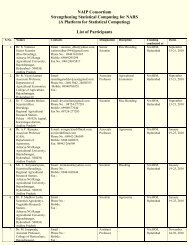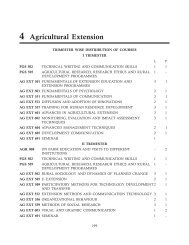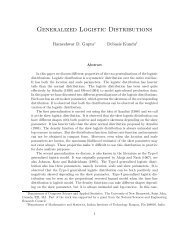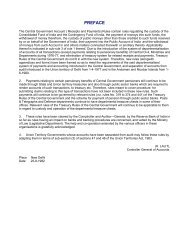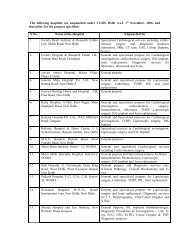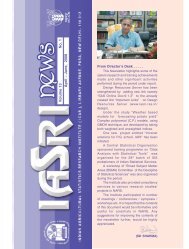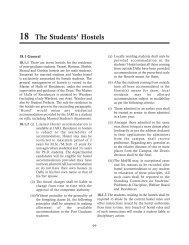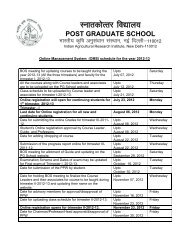DESIGNS FOR CROP SEQUENCE EXPERIMENTS: A CASE ... - IASRI
DESIGNS FOR CROP SEQUENCE EXPERIMENTS: A CASE ... - IASRI
DESIGNS FOR CROP SEQUENCE EXPERIMENTS: A CASE ... - IASRI
You also want an ePaper? Increase the reach of your titles
YUMPU automatically turns print PDFs into web optimized ePapers that Google loves.
<strong>DESIGNS</strong> <strong>FOR</strong> <strong>CROP</strong> <strong>SEQUENCE</strong> <strong>EXPERIMENTS</strong>:<br />
A <strong>CASE</strong> STUDY<br />
Rajender Parsad and V.K. Gupta<br />
I.A.S.R.I., Library Avenue, Pusa, New Delhi – 110 012<br />
rajender@iasri.res.in; vkgupta@iasri.res.in<br />
1. Introduction<br />
In Indian National Agricultural Research System (NARS), many experiments are conducted for<br />
cropping systems research wherein a crop sequence of two crops is grown; one in Kharif season<br />
followed by another in Rabi season. More than two crops may also be grown in crop sequence<br />
experiment, but we focus our attention to only two crops grown in the sequence. The extension<br />
to three crops would follow naturally. In these experiments two different sets of treatments are<br />
applied in succession with one set applied in Kharif crop and the other set applied in Rabi crop.<br />
The observations are recorded in both the crop seasons. In two-crop sequence experiments, the<br />
interest of the experimenter is in direct effects of treatments applied in Kharif and Rabi season<br />
and residual effects of Kharif treatments. The interaction between the residual effect of Kharif<br />
crop treatments and the direct effect of Rabi crop treatments may or may not be of interest to the<br />
experimenter. These experiments may be run in a block design to account for the variability in<br />
the experimental material.<br />
Crop sequence experiments run in block designs can be viewed as block designs with factorial<br />
structure of treatments. For example if m treatments are applied in the Kharif crop and n<br />
treatments are applied in the Rabi crop, then on the application of n treatments in the Rabi crop, a<br />
maximum of mn treatment combinations may appear and the treatment structure is factorial in<br />
nature. These experiments are classified into two broad categories. Category I experiments are<br />
those in which all the possible mn treatment combinations applied in both the crops are taken for<br />
experimentation; in other words, one has a complete factorial experiment run in a block design.<br />
In these experiments, the interaction between the residual effect of Kharif crop treatments and<br />
the direct effect of Rabi crop treatments are also of interest to the experimenter. Category II<br />
experiments are similar to the category I experiments with the difference that after the<br />
application of n treatments in the second crop, all the mn treatment combinations do not appear.<br />
In other words, it is a fractional factorial plan rather than a complete factorial experiment run in a<br />
block design. Further, the interaction between residual effect of Kharif treatments and direct<br />
effect of Rabi treatments is not of interest to the experimenter.<br />
Experimental Situation 1: An experiment on Rice-Wheat sequence was conducted in the Division<br />
of Agronomy, IARI, New Delhi. During the Karif crop (Rice), 5 herbicidal treatments, denoted as<br />
1, 2, 3, 4, 5 were applied. On the following Rabi crop (Wheat), 4 herbicidal treatments, denoted as<br />
a, b, c, d, were given. The purpose of the experiment was (i) to compare direct effects of Kharif<br />
and Rabi treatments, (ii) residual effects of Kharif treatments, and (iii) interaction between residual<br />
effects of Kharif and direct effects of Rabi treatments.<br />
The design recommended and adopted was a resolvable rectangular design with v = 5×4 (=20), b<br />
= 6, r = 3 and k = 10. Blocks 1 and 2 form first replication, blocks 3 and 4 form the second<br />
replication and blocks 5 and 6 form the third replication. This design has a factorial treatment
Designs for Crop Sequence Experiments: A Case Study<br />
structure with two factors, one at 5 levels and the other at 4 levels. Relative efficiencies of main<br />
effect of first factor (residual effect of Kharif treatments), main effect of second factor (direct<br />
effect of Rabi treatments) and interaction of first and second factors as compared to the<br />
randomized complete block design are ∈(10)=1, ∈(01)=2/3, ∈(11) = 1, respectively. The layout<br />
of the design is<br />
Replication I Replication II Replication III<br />
Block 1 Block 2 Block 3 Block 4 Block 5 Block 6<br />
1a 1c 1a 1b 1b 1a<br />
2a 2c 2a 2b 2b 2a<br />
3a 3c 3a 3b 3b 3a<br />
4a 4c 4a 4b 4b 4a<br />
5a 5c 5a 5b 5b 5a<br />
1b 1d 1d 1c 1d 1c<br />
2b 2d 2d 2c 2d 2c<br />
3b 3d 3d 3c 3d 3c<br />
4b 4d 4d 4c 4d 4c<br />
5b 5d 5d 5c 5d 5c<br />
The analysis of the data generated from such an experiment is:<br />
ANOVA for resolvable design (YEAR I)<br />
Kharif Season<br />
Rabi Season<br />
Source DF Source DF<br />
Between Blocks 5 Between Blocks 5<br />
Kharif Treatments 4 Residual (Kharif Treatments) 4<br />
Error 50 Direct (Rabi Treatments) 3<br />
Total 59 Residual * Direct 12<br />
Error 35<br />
Total 59<br />
If same randomization on same experimental area is followed in second year, then one can<br />
analyze the data as<br />
366
Designs for Crop Sequence Experiments: A Case Study<br />
ANOVA for resolvable design (YEAR II)<br />
Kharif Season<br />
Rabi Season<br />
Source DF Source DF<br />
Between Blocks 5 Between Blocks 5<br />
Residual (RabiTreatments) 3 Residual (Kharif Treatments) 4<br />
Direct (Kharif Treatments) 4 Direct (Rabi) 3<br />
Residual * Direct 12 Residual * Direct 12<br />
Error 35 Error 35<br />
Total 59 Total 59<br />
The best treatment can be picked through the usual block design analysis as below. The steps for<br />
analysis of data on test weight of wheat crop is given as:<br />
data egdgopi;<br />
input rep blk kh rabi $ trt tw;<br />
/*rep=replication, blk=block, kh=kharif, rabi=Rabi, trt=treatment, tw=test<br />
weight of wheat*/<br />
cards;<br />
1 1 3 a 9 40.33<br />
1 1 4 b 14 40.8<br />
1 1 1 b 2 40.66<br />
1 1 5 a 17 40.22<br />
1 1 2 b 6 39.9<br />
1 1 5 b 18 41.3<br />
1 1 4 a 13 40.2<br />
1 1 2 a 5 41.15<br />
1 1 1 a 1 41.2<br />
1 1 3 b 10 40.75<br />
1 2 2 a 5 39.9<br />
1 2 3 c 11 41.75<br />
1 2 1 a 1 38.48<br />
1 2 5 a 17 40.04<br />
1 2 4 c 15 40.72<br />
1 2 5 c 19 41.15<br />
1 2 1 c 3 41.76<br />
1 2 2 c 7 41.03<br />
1 2 3 a 9 39.44<br />
1 2 4 a 13 39.4<br />
2 3 4 d 16 39.03<br />
2 3 2 a 5 40.2<br />
2 3 5 a 17 40.12<br />
2 3 5 d 20 40<br />
2 3 3 d 12 38.78<br />
2 3 3 a 9 40.55<br />
2 3 1 a 1 40<br />
2 3 2 d 8 38.89<br />
2 3 1 d 4 39.27<br />
2 3 4 a 13 39.32<br />
2 4 3 b 10 41<br />
2 4 4 c 15 42.8<br />
2 4 2 b 6 41.26<br />
367
Designs for Crop Sequence Experiments: A Case Study<br />
2 4 1 b 2 39.95<br />
2 4 5 b 18 40.65<br />
2 4 5 c 19 41.25<br />
2 4 2 c 7 41.4<br />
2 4 3 c 11 40.95<br />
2 4 4 b 14 40.83<br />
2 4 1 c 3 41.44<br />
3 5 1 b 2 40.7<br />
3 5 3 b 10 40.18<br />
3 5 2 d 8 37.62<br />
3 5 2 b 6 40.46<br />
3 5 4 d 16 38.96<br />
3 5 4 b 14 39.8<br />
3 5 1 d 4 37.36<br />
3 5 3 d 12 39.00<br />
3 5 5 b 18 40.52<br />
3 5 5 d 20 38.1<br />
3 6 1 d 4 39.15<br />
3 6 4 d 16 39.1<br />
3 6 2 c 7 42.6<br />
3 6 3 c 11 41.92<br />
3 6 2 d 8 39.96<br />
3 6 3 d 12 38.77<br />
3 6 1 c 3 41.07<br />
3 6 4 c 15 43.54<br />
3 6 5 d 20 39.22<br />
3 6 5 c 19 40.05<br />
;<br />
proc glm;<br />
class rep blk trt kh rabi;<br />
model tw = rep blk(rep) kh rabi kh*rabi/ss3;<br />
means kh rabi kh*rabi/lsd;<br />
lsmeans rabi rabi kh*rabi/pdiff lines;<br />
lsmeans rabi rabi kh*rabi/pdiff slice =rabi;<br />
run;<br />
proc glm;<br />
class rep blk trt kh rabi;<br />
model tw = rep blk(rep) trt/ss3;<br />
means kh rabi kh*rabi/lsd;<br />
lsmeans rabi rabi kh*rabi/pdiff lines;<br />
lsmeans rabi rabi kh*rabi/pdiff slice =rabi;<br />
run;<br />
The data on next year rice and wheat can also be analysed similarly.<br />
Some References<br />
Gupta, V.K. and Parsad, Rajender (2009). Block Designs for Cropping Systems Research.<br />
NAAS News. 8(2), 3-7.<br />
Parsad, Rajender, Gupta, V.K. and Srivastava, R. (2007). Designs for cropping systems research.<br />
Journal of Statistical Planning and Inference, 137, 1687-1703.<br />
368



